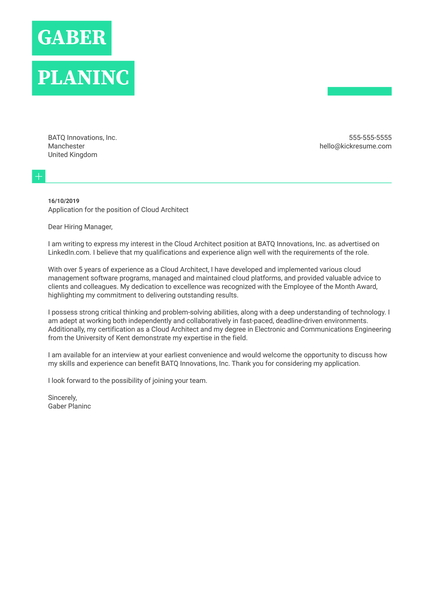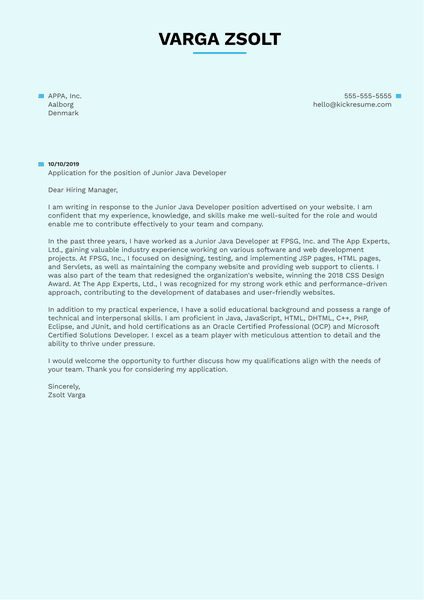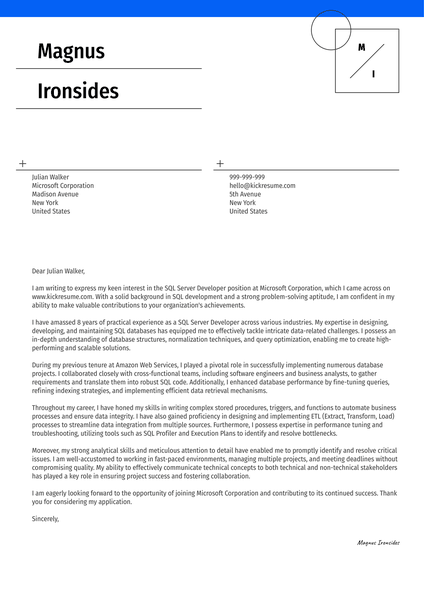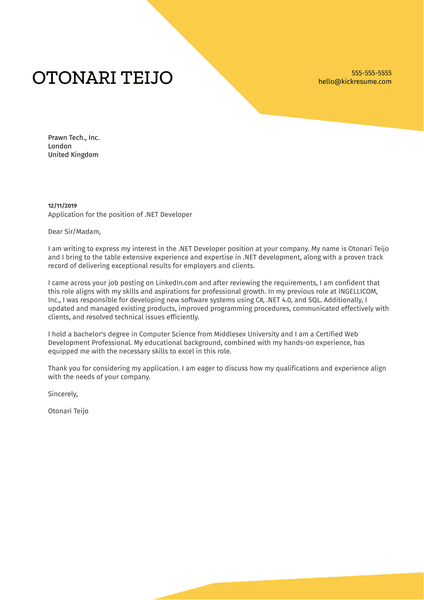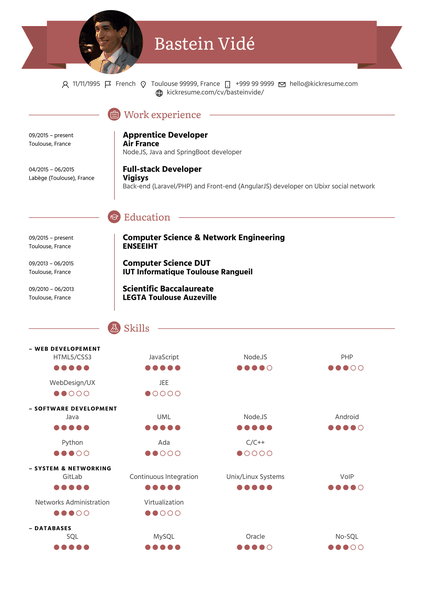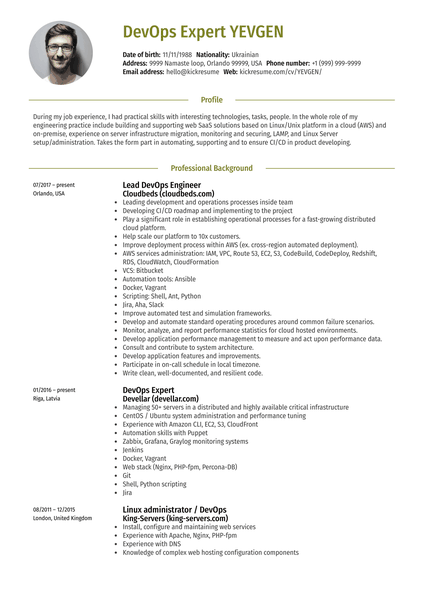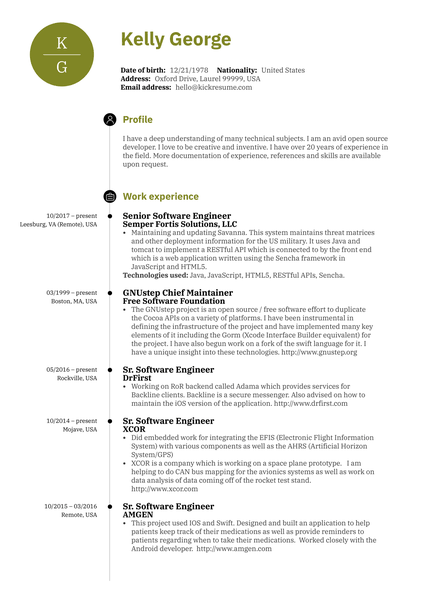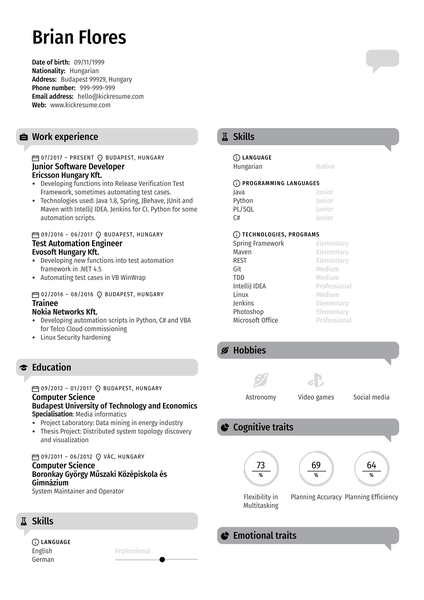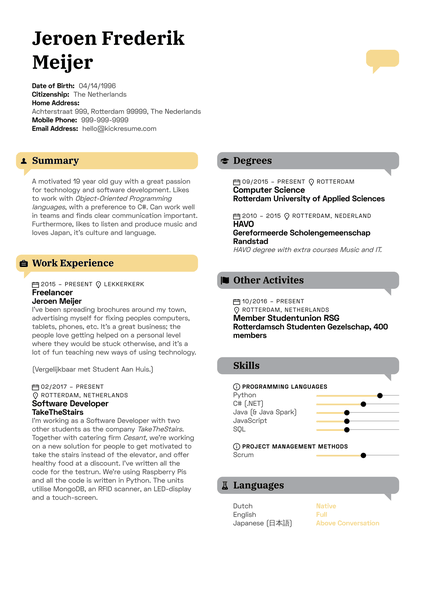Crafting a standout back-end developer cover letter can often feel as complex as a tricky coding algorithm. It requires the right balance of clarity and sophistication.
But it's no Gordian Knot. More like untangling your headphones after they've spent a day in your pocket. Our ultimate guide filled with handy tips and real-world examples simplifies the process and goes straight to the point — writing a cover letter that lands you interviews.
And so, without further ado, let’s dive into the art of crafting a cover letter that showcases your expertise, passion, and drive as a back-end developer.
Keep reading to learn more about:
- Formatting your back-end developer cover letter correctly
- Composing an impactful header
- Crafting an engaging cover letter headline
- Personalizing the greeting in your cover letter
- Creating a powerful introduction for your back-end developer cover letter
- Highlighting your technical skills and achievements
- Developing a compelling conclusion
- Avoiding common mistakes in back-end developer cover letters
- Average earning potential and job outlook for back-end developers
- Useful resources for aspiring back-end developers in the job market
1. How to properly format your back-end developer cover letter
Crafting your back-end developer cover letter involves more than just putting fingers on the keyboard. It's about formatting it in a way that engages the reader and precisely presents your credentials.
Here are some tips to format your letter:
- Division: A well-structured cover letter has three parts: an introduction, body, and conclusion. This division aids readability, and helps ensure your points are clearly communicated.
- Use white space: Like an indisputable code with clean breaks, buffer your text with ample white space. It enhances readability and gives the document a clean, professional look.
- Font and line spacing: Use a professional font such as Times New Roman or Arial. The font size should be between 10 and 12 points. Line spacing should be 1.15 or 1.5 to make your letter easy on the eyes.
- Margins: Stick to 1" margins on all sides. It gives your letter a balanced look and ensures nothing gets clipped when printed.
- Align text: Left alignment is standard. Avoid centering or justifying your cover letter text — it can create a disorganized appearance.
- Bold and italics: Use bold and italics sparingly on important parts like section headers or company names. But be restrained — the use of such stylistic features should aim to make important information stand out, not overwhelm the reader.
- Bullet points: They are excellent for listing achievements, skills or projects, making them easier to comprehend. Just as a well-written function makes code more effective, properly used bullet points make a cover letter more impactful.
- Length: When it comes to cover letters, less is more. Aim for a single A4 page. If your achievements can't be summarized on one page, revisit them and trim down to the most relevant.
Formatting a cover letter as a back-end developer goes beyond the codes you write. It needs attention to detail — similar to creating a flawless operational program.
It's about ensuring your letter is structured, easy to read and conveys your message effectively. Remember, the final product should read as elegantly as well-scripted code.
2. Create an impactful back-end developer cover letter header
Your cover letter's header is crucial. Not only does it house all your vital contact information, but it's also the first thing the hiring manager sees. Despite its importance, this section is often overlooked. So, let's change that and nail the cover letter header together.
The header should contain your contact information, the date, and the recipient's information. Specifically, this includes:
- Your full name
- Your address
- Your contact number and email address
- The current date
- The recipient's full name (when known)
- The recipient's position
- The company's address
The importance of a correct header lies in providing clear contact information and demonstrating your attention to detail.
Incorrect cover letter header example
Mark Smith, Backcrafter Inc, 12345 Main St, City
Why is it weak? The example above fails to include vital information such as Mark's contact number and email address, the current date, and the recipient's information. Given its brevity, it seems more like a subheading than a header.
Correct cover letter header example
Mark Smith
123 Backward Ln, City State, Zip
smith.mark@gmail.com | 123-456-7890
Date: January 1, 2023
To: Mr. John Doe
Hiring Manager
Backcrafter Inc
12345 Main St, City, State, ZIP
Why does it work? This example provides all the required contact information in a neat and well-organized manner, ensuring that whoever reads the letter knows exactly who it's from and how to contact them.
All in all, the header of your cover letter sets the stage for the communication that follows. It's a concise, orderly way to present your fundamental contact information and contributes to the overall first impression of your application.
So, don't rush through it. Investing time in creating a professional header can set a strong, positive tone for the rest of your application.
3. How to write a compelling cover letter headline
Next on your cover letter crafting journey comes the headline. This is your golden opportunity to pull the hiring manager's attention towards your application.
A compelling headline should be clear, precise, and unequivocally state your intent. While it isn't the place to showcase your mastery of coding languages, it serves to express your professional aspirations and hint at why you're an ideal candidate.
Here are two contrasting examples to show what works and what does not:
Weak cover letter headline example
Looking for a Back-End Developer Job
Why doesn’t it work? While this headline is straightforward, it lacks detail and fails to make an impression. It doesn't mention the role you're interested in or why you're a desirable candidate.
Strong cover letter headline example
Passionate Back-End Developer with 5 Years of Experience Ready to Boost Efficiency at ChicTech Global
Why does it work? This headline hits the mark. It clearly states the professional title, shows enthusiasm for the specific role, and directly introduces the company's name. It's targeted, specific, and immediately communicates your intent.
The key takeaway? Be direct, specific, and concise. A vibrant headline draws the hiring manager in, leading them towards your introduction and skills with a heightened level of interest.
4. How to customize the greeting on your back-end developer cover letter
Starting a conversation on the right note determines how the rest of it unfolds. Similarly, the greeting in your cover letter sets the tone for the rest of the document. A personalized greeting can make a significant impression on the hiring manager.
Why is it essential to customize? A personalized greeting reiterates your interest in the role, shows your attention to detail, and demonstrates respect for the reader.
It's an effective way to stand out among a sea of generic applications. The best way to personalize your greeting is by finding and using the hiring manager's name. While it may be a challenge, a little sleuthing can go a long way:
- Company website: Often, you can find the name in the 'About Us' or 'Our Team' section.
- LinkedIn: The company's LinkedIn page can provide valuable information.
- Job listing: Sometimes, the job post will mention an application contact.
Provided you can find the name, here are ways to use it effectively:
Personalized greeting examples
Dear Mr. Johnson,
Dear Mr. Mike Johnson,
Dear Hiring Manager Mike Johnson,
Should you come up short in your hunt for a name, there are still professional alternatives:
General greeting examples
Dear Hiring Manager, — A solid choice, though impersonal.
Dear [Interested Team] Team, — More specific, and shows you know which team you would be joining.
Dear [Company Name] Recruiter, — This greeting communicates you know who will likely be reading your letter.
Taking the time to personalize the greeting in your cover letter can set you apart from other candidates. It stands as a testament to your professionalism and your commitment to the role you're applying for.
5. How to write a strong introduction to your back-end developer cover letter
The introduction of your cover letter is where you make your first impression. It sets the tone, stimulates interest, and provokes the recipient to read further.
Ideally, it should incorporate a snapshot of your professional and academic history, indicate why you're interested in the position, and reference any mutual acquaintances or shared connections if applicable.
Let's delve into three examples, each of which highlights a specific type of introduction.
Weak cover letter introduction example
I'm applying to the job advertised. I've got a degree in computer science and have worked in a few companies.
Why is it weak? This opener lacks energy, customization, and specificity. It does mention a degree and previous work experience but fails to identify any special worth the applicant can bring to the company or mention the specific job position.
Strong cover letter introduction example for an experienced candidate
As a seasoned Back-End Developer with 8 years of experience in writing robust and optimized code, I was excited to see the open Back-End Developer position at XYZ Corp. Leveraging my passion for creating efficiency-boosting software, I look forward to contributing my innovative solutions to your technologically advanced environment. Interestingly, I have been fortunate to work with your CTO, Ms. A, at ABC Tech in the past.
Why does it work? The candidate immediately states their role, experience, and genuine interest in the job position, making it clear what they do and what they desire. The mention of a shared connection adds weight to the application.
Are you a fresh-faced graduate with a lack of experience to tap into? Fear not! Here's how to construct an engaging opening:
Strong cover letter introduction example for a fresh graduate
As a recent computer science graduate with a specialty in back-end development, I am eager to apply my learning to a real-world corporate environment. The opportunity to work as a Back-End Developer at XYZ Corp. aligns with my career ambitions and my goal to optimize software functionality through the creation of efficient algorithms and data structures. I first learned about your company through my university career center, and the more I found out about XYZ Corp., the more I felt it to be the perfect place for me to start my career.
Why does it work? As it is an entry-level application, it's essential to highlight one's academic strengths and potential value they can bring to the organization even with limited workplace experience. The candidate here showcases a clear understanding of their field of study, eagerness to apply their knowledge, and a genuine interest in this particular company based on their research.
A well-composed introduction is an excellent way to attract the hiring manager's attention. It helps position you as not just another job-seeker but as a potential asset to the team.
Remember, the best introductions are short, direct, and infused with a dash of your personality and enthusiasm. Start strong, and let the rest of your cover letter keep the momentum going.
6. Showcase your top skills and accomplishments
When you describe your skills, accomplishments, and other qualifications, it is crucial to include information that is highly specific and relevant to the job you are applying to.
For instance, if an employer is looking for a back-end developer trained to use Python, you should not only state your experience with Python but also provide an example of how you have used Python in your previous work or place of employment.
Here are 6 skills to mention in a back-end developer cover letter
- Fluency in programming languages
- Debugging back-end systems
- Creating back-end components
- Integrating back-end processes to front-end interfaces
- Communicating effectively with other developers
- Strict adherence to deadlines
What stands out is the inclusion of not only the expected technical competencies, such as fluency in programming languages and the ability to debug back-end systems, but also the emphasis on teamwork and deadline management.
These are often undervalued yet critical in a dynamic work context where collaboration and delivery timeframes are paramount.
Remember, illustrating these skills through concrete examples from previous roles can make your application even more compelling. If you can provide a narrative where you have successfully employed these skills, it would convey your value beyond a mere checklist of abilities.
Here are a few examples of how to describe accomplishments in a back-end developer cover letter
- As a back-end developer for [Former Employer], one of my key responsibilities was testing the core system for bugs and errors. After developing a new automated response system for identifying such errors, I reduced the overall occurrence of bugs by 35%, as well as reduced the need for human intervention by 50%.
- I successfully implemented a robust and scalable back-end infrastructure for a high-traffic e-commerce website, resulting in a 50% increase in website performance and a significant reduction in downtime."
- I collaborated with cross-functional teams to develop and deploy a RESTful API that streamlined data retrieval and improved overall system efficiency. This led to a 30% reduction in response time and enhanced user experience."
- I played a key role in optimizing database queries and query performance, resulting in a 40% reduction in database response time and significantly improving application speed and reliability."
- I designed and implemented a secure authentication and authorization system, incorporating industry best practices and encryption protocols. This enhanced data security, mitigated potential risks, and ensured compliance with privacy regulations.
Essentially, the presentation of your skills, qualifications, and accomplishments in your back-end developer cover letter is an art. It's not about listing your skills, but about demonstrating their application in a tangible and employer-relevant context.
As with your code, let your resume be an expression of your experience, achievements, and potential, merging into a powerful narrative.
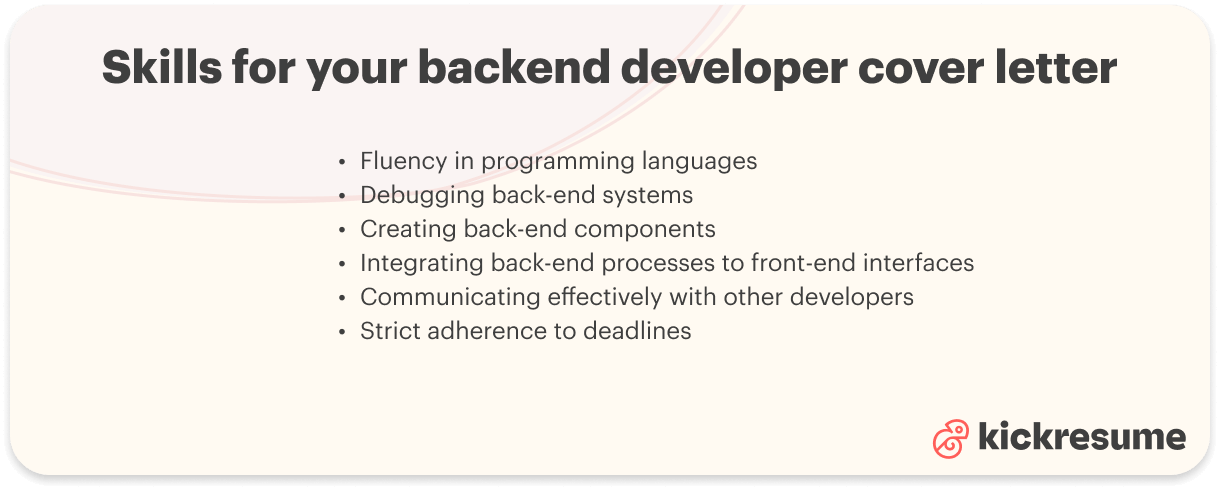
7. How to persuasively conclude your back-end developer cover letter
Just like the finale of a well-executed coding project, the conclusion of your cover letter is vital. It's your final chance to leave a lasting impression on the hiring manager and to encourage them to take the next step — get in contact with you.
A persuasive conclusion should reiterate your interest in the position, express appreciation for the reader's time, and specify how and when you can be contacted.
It's also good practice to clarify your follow-up plan. Lastly, don't forget a formal sign-off, it's like the 'end' statement in the programming script.
Let's examine examples of both a weak and a strong conclusion for a bac-kend developer cover letter:
Incorrect back-end cover letter conclusion example
Let me know if you're interested in my profile.
Regards,
[Your Name]
Why is it weak? This conclusion is lacking on several fronts. It sounds casual, fails to express specific interest in the role, doesn't provide clear contact details, and, importantly, doesn't offer a clear action plan for follow-up.
Correct cover letter conclusion example
I am enthusiastic about the opportunity to join XYZ Corp and contribute my back-end development expertise to your innovative projects. Thank you for considering my application. I'm available via email and phone for any further discussion and look forward to hearing back from you within the next two weeks.
If I have not heard by then, I will follow up with a call to ensure my application was received.
Yours sincerely,
[Your Name]
Why does it work? This conclusion conveys confidence yet remains respectful. It provides clear contact details, shows appreciation, and outlines a forthcoming follow-up plan without sounding pressuring. It ends with a professional sign-off.
Overall, a well-crafted conclusion reaffirms your suitability for the role, shows your interest, and drives the hiring manager to take action. It simply provides closure but keeps the conversation going, paving the path towards a potential interview.
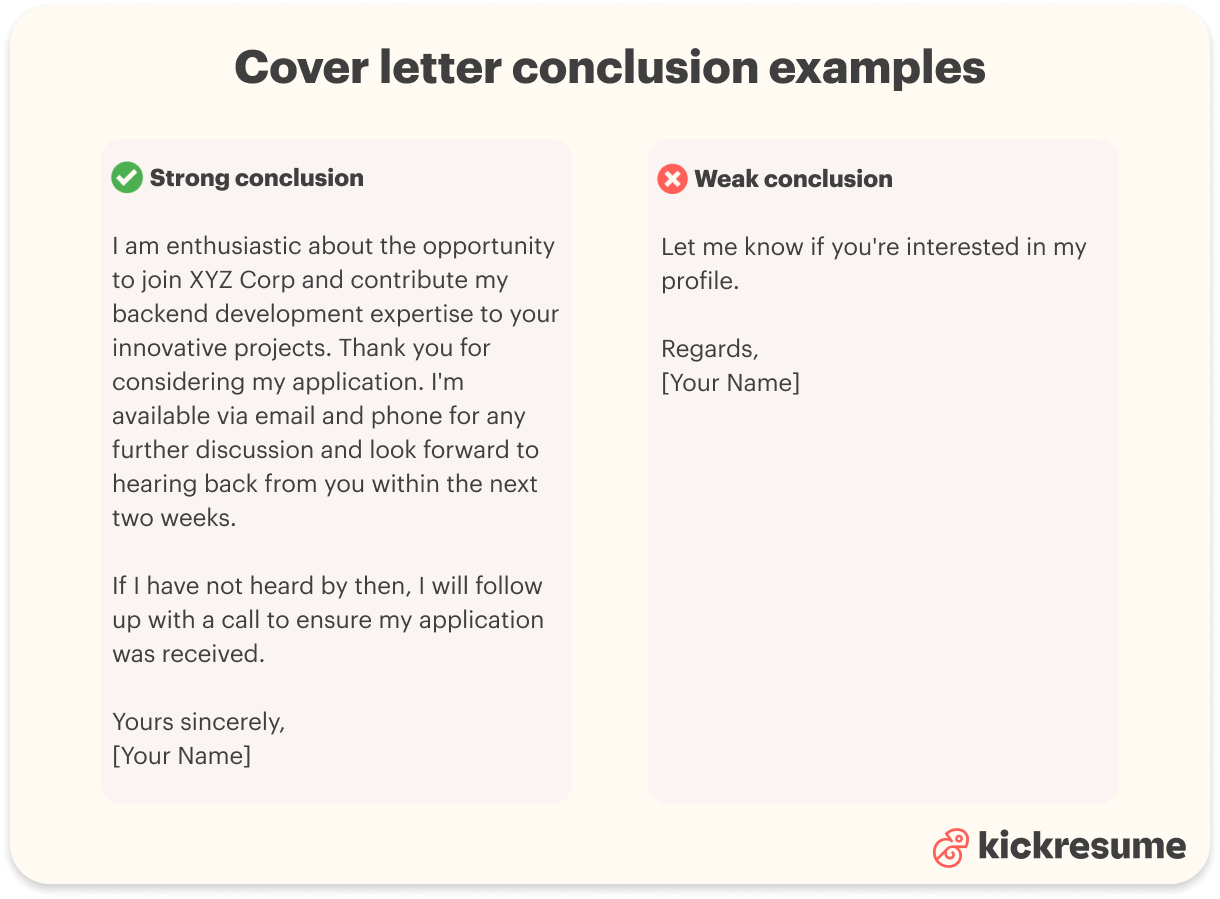
8. How to avoid common mistakes on a back-end developer cover letter
While crafting a back-end developer cover letter, it's important not just to articulate your strengths, but to avoid common pitfalls as well. Here are some common mistakes that job seekers often make:
- Vagueness: Your cover letter should be detailed and specific about your capabilities and your fit for the job. Don't simply state that you have "experience in back-end development." Instead, provide clear examples of projects you've worked on, languages you've mastered, and how your skills would benefit the organization.
- Overlength: Keep it concise. An excessively long cover letter may lose the reader's interest. The rule of thumb is to limit your cover letter to a single page.
- Neglecting value: Remember, the hiring manager wants to know what you can offer the company, not what the company can offer you. Focus more on how you can contribute to the organization rather than focusing only on what you hope to gain.
- Ignoring company culture: If the company prides itself on a specific aspect, such as innovation or teamwork, make sure to touch on that in your cover letter. It shows you've done your research and see yourself fitting into their culture.
- Typos and grammar errors: This might seem a no-brainer, but you'd be surprised how often typos appear in cover letters. Be sure to proofread your letter thoroughly. If you miss a ";" in your code, it won't run. Similarly, errors in your cover letter negatively impact the overall presentation.
- One size fits all approach: Tailor your cover letter to each specific job application. Sending the same cover letter, unchanged, to numerous companies, shows a lack of genuine interest in the position.
Your back-end developer cover letter should be a clear, polished and personalized presentation of your professional expertise and potential for value addition. Remember, avoiding these common mistakes can increase your chances of landing that dream job.
9. Average salary and outlook for back-end developers
If you're contemplating a career as a back-end developer, it's essential to keep yourself informed about the latest market trends and future prospects.
According to the most recent data from the Bureau of Labor Statistics, as of May 2022, back-end developers were earning, on average, an enticing wage of $80,730 per year. This figure presents promising potential for those considering this career path.
Moreover, the job outlook for back-end developers is quite robust. From 2022 to 2032, the overall employment in this field is projected to grow by a substantial 16%, a pace much faster than the average for all occupations. This expected growth means promising job opportunities in the industry.
Adding to this, an average of 19,000 job openings per year are projected within the decade for back-end developers. This data further emphasizes the growing opportunities available in this field.
And so, choosing a career as a back-end developer opens lucrative earning possibilities and a strong job market. Now, more than ever, it may well be the perfect time to consider diving into it.
10. Essential resources for back-end developer job seekers
Whether you're beginning your journey as a back-end developer or are an experienced professional staying updated with the latest trends, it's essential to leverage valuable resources in the field.
Below, find some suggestions to keep in step with the fast-paced world of back-end development:
- Online courses and certifications: Pursuing online courses or certifications, such as those offered by Coursera, Udacity, or Codecademy, can sharpen your skills in specific areas. Additionally, getting certified adds significant weight to your resume, showing potential employers that you're committed to continuous learning.
- Job search websites: The online platforms like Dice, Hired, Indeed, and LinkedIn Jobs are teeming with opportunities for back-end developers. They host a wide array of positions across different locations and levels of experience. Keeping a close watch on the listings will give you a good sense of the market and help identify opportunities that align with your career goals.
- Industry blogs and forums: Regularly following industry-standard blogs like SitePoint, Smashing Magazine, or David Walsh Blog, and contributing to forums like Stack Overflow, can keep you abreast of the latest developments and challenges in the field.
- Networking: Connecting with fellow developers and participating in events and meetups can provide valuable insights, solve queries, or even lead to potential job opportunities. Check out professional associations like the Association of Software Professionals or online communities on LinkedIn and Reddit for back-end developers.
- Open source contribution: Contributing to open-source projects or developing your own projects on platforms like Github not only enhances your portfolio but also provides practical experience of working on real-life projects.
- Stay updated with job trends: Regularly visit online job portals and company websites to understand what skills are in demand. Tailoring your learning accordingly can enhance your job prospects.
Beyond these resources, the key to success in this field is constant learning and adapting. With the tech industry's ever-evolving nature, being flexible and thirsty for knowledge would indeed take you a long way in your back-end developer career.
Back-End Developer / Engineer Cover Letter FAQ
What should I consider before writing my back-end developer cover letter?
Before you get started, read through the job description carefully. Identify key skills and qualifications the employer is looking for and align your relevant experience with those areas. Research the company to understand its culture and mission, so you can tailor your cover letter to demonstrate why you'd be a good cultural fit.
How do I make my cover letter stand out?
To make your cover letter stand out, ensure it's tailored specifically to the job and company you're applying to. Use action verbs and quantify achievements where possible. Show enthusiasm for the role and the company. Make sure your letter is free of spelling and grammatical errors.
Can I apply for a back-end developer position even if I don’t meet all the job requirements?
It's common for job seekers not to meet 100% of the job requirements. Employers list their ideal set of skills and experience, but they understand that the perfect candidate who ticks every box might not exist. If you meet a good portion of the requirements and believe you can do the job, go ahead and apply.
I’m transitioning from a different field into back-end development, how do I reflect this in my cover letter?
When making a career shift, focus on transferable skills that you've gained from your previous roles that can be applied in the field of back-end development. It could be problem-solving skills, project management skills, or even a detail-oriented approach. Also, mentioning any relevant courses or certifications can show your commitment to the new field.
Is it okay to follow up after submitting my back-end developer cover letter?
Yes, it's perfectly acceptable to follow up after submitting your application unless the job listing specifically requests no follow-ups. A brief email or phone call can help underscore your interest in the position and ensure your application gets noticed. Typically, waiting about one to two weeks before following up is recommended.
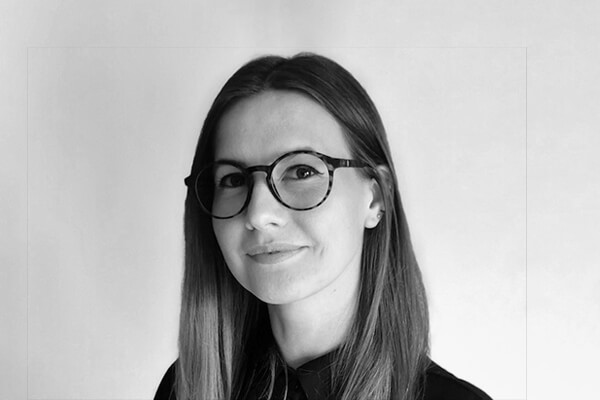
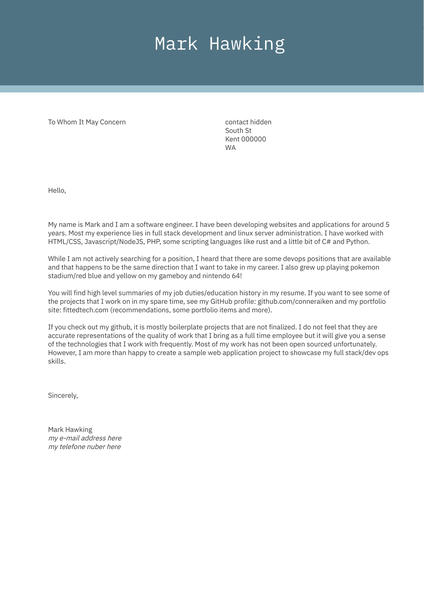

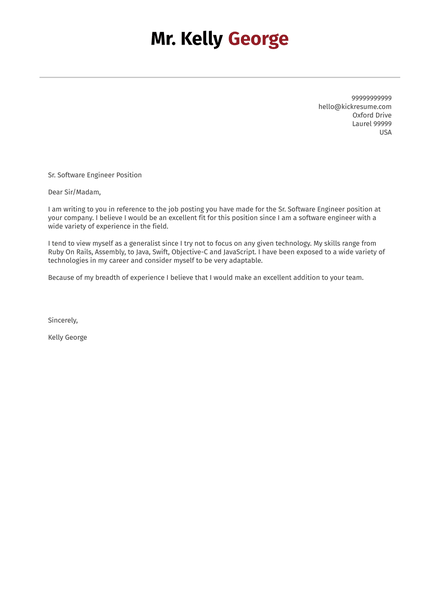
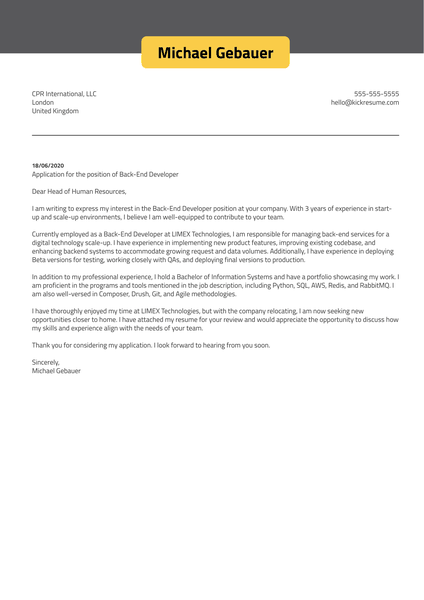


![Webmaster/webmestre Cover Letter Example [FR]](png/thumbnail-82.png)

